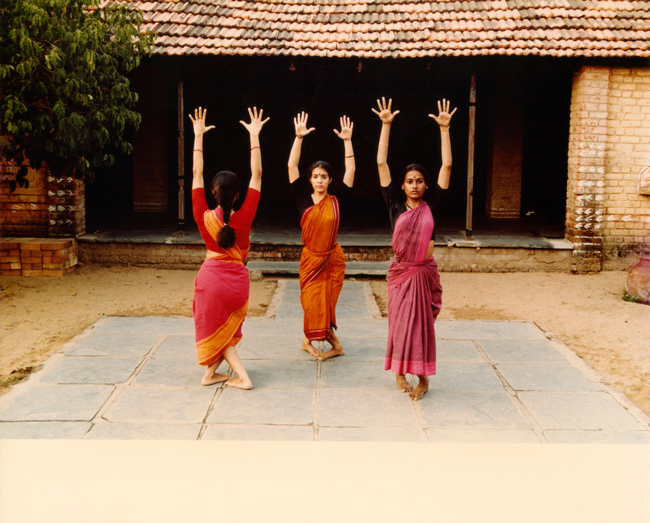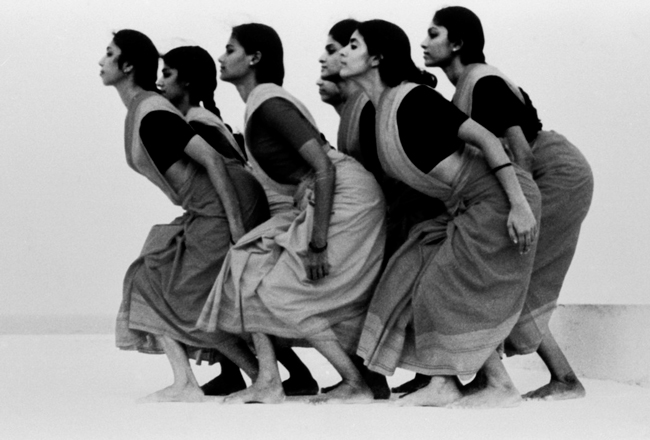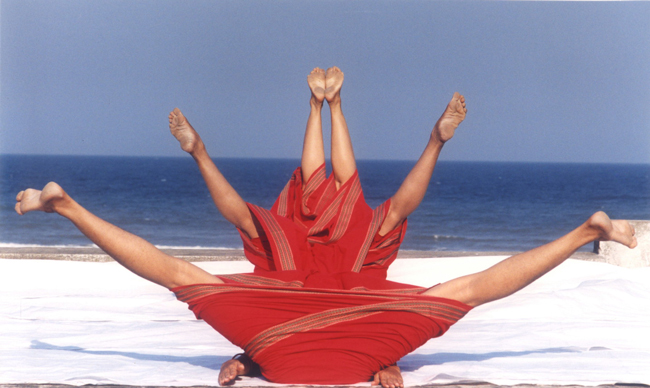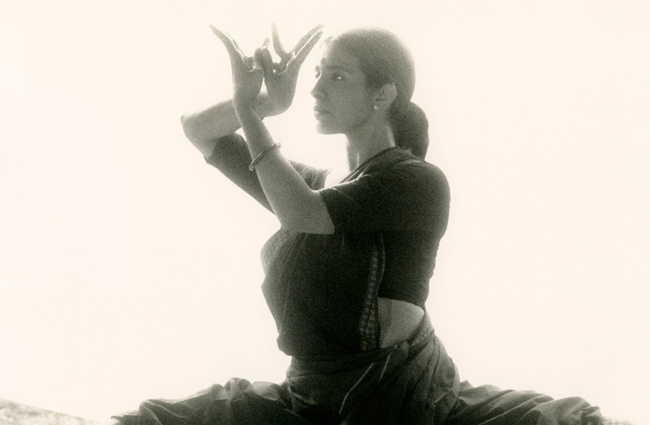From Sri to Sharira―Chandralekha's Works since the 1990s

This is Chandra herself, I think at the age of 65, opening the performance called Sri, which is a seminal piece of hers, which was really a mapping of the women's movement in India. That's how she would describe it. And the opening image... this is what she called Sakambhari, the tree of life. But the tree of life here is an upside-down woman, and at the end of this inverted moment Chandra opens her legs wide, and she says, "The tree of life grows out of my body." Later she comes back to this moment. The reason I've shown this image is because it returns in the last piece that I made with her, where she says, "But woman gives birth to man. And woman isn't giving birth to babies." It was a very different thinking for her, but it was somehow at the root of what she was proposing as a new feminism in a way. Yes, it is an image of woman that she wanted to put out into the world. To take the idea of woman as the domesticated housewife, the mother of babies, somehow brutalised by all of these, what she referred to also as, "The patriarchal drudgery." Somewhere this was her opening to this piece, Sri.

The piece Sri, I'm going to focus a little bit on it because somewhere was requested here to also highlight a little bit the feminist dialogue that was there. And this is the... After the tree of life, the piece starts with this image, which is of matrikas, where Chandra is referring to images of women from pre-religious times in India, looking around India for very old depictions of women as warriors somehow, women holding weapons, women holding strength. And so the first half hour of the performance is the matrika women. This is followed by a very famous image as well, where she introduces the idea of patriarchy through a very brief sequence of a man holding a woman's hand, as in a very traditional wedding ceremony. And this is the transition into the image she called 'women with broken spines'. We used to call this the dragwalk, it was very painful to perform.

Her point was that the spine is the metaphor for freedom, and in the way that men have pushed women into certain domestic roles and have taken away freedom and empowerment from women, the backs are broken, spirits diminished. And later she says, in the last part of Sri, she had a vision that women would reclaim their spines and come back into the world as warrior women. And this is the last, it's a very militant kind of moment, everybody's jumping and chopping, their arms out. And the piece ends actually with the large image of Dashabhuja, which again has an iconic reference. It's a goddess with multiple hands, and for her that was her vision. She said, "To live as a woman in today's world, we need multiple hands, multiple energies." That was the last image of Sri.

Sri, which we performed mostly in the early '90s, I think in a way... One thing I wanted to say quite early on, but I haven't focused on that element in this talk, was that a lot of the possibility for Chandra's work to be made, to be produced and at times performed, was actually the kind of support that she received in those years from the Goethe-Institut. And I say this not accusingly, or wanting to make a point about imperialist interventions, but I say it in a way because it seems ironic that 50 years after this time in India today, still a lot of the space and support for contemporary dance comes from the Goethe Institut This has its own dynamic and the plusses and the minuses, and the reason I brought that up now was to come to this image of Yantra made in 1994. This was in a way a homage to Pina Bausch. It was a commission from the Goethe-Institut, an invitation from the Goethe Institut to make a piece to specially honour the 1994 tour of Pina Bausch in India. The offer was to have a festival going through the cities of India where Pina Bausch would perform Nelken, and Chandralekha's company would perform Yantra. This was an image from that piece that she made. To add a small footnote, I have a feeling that in the later years of her career, Chandra herself started to question the role of European funding and interference in work being made in India. In the mid-nineties when my own productions began, she often urged me not to receive funding from Europe. This is a conversation with her that I have reflected on multiple times...

There were many interesting conversations, cross-fertilisation, thinking, between actually those generations of German choreographers. There was Pina Bausch, of course, but also more importantly dancers such as Susanne Linke, who were close friends of Chandra, often coming to her theater and working with us in a way that wasn't about imparting a form or a technique, but really with a lot of openness and generosity, just sort of almost playing with each other's senses of things in the body. I think, for myself as a young dancer, it opened many worlds to me, to see the way in which these knowledge systems could interact, that there could be a dialogue. I think there was a dialogue that wasn't about ownership or appropriation, which was just really a very open place. I think that that was a very precious time of learning. The reason I say this is because having worked ten years in this space, it was an education that cannot be replaced in a dance academy. An education where the body, dance, aesthetics, ethics and politics were interwoven to create an ideal starting point for my own choreographic thinking.

This is an image from Raga (1998). These are the last works of Chandra, where she started to very much again think about the compartmentalisation of certain terms as opposed to interconnectivity which she saw as part of the Indian thought tradition. "What do these words that describe gender mean? What is femininity? What does it mean to look for the feminine within the masculine body? What is this sensuality that's actually enacted in these old practices of massaging the body?" With Chandra, she was always exploring in a very playful, yet irreverent way. She didn't think ever, "Oh, well. This is dance. This isn't dance," somewhere. For her, anything could become dance. I think with a lot of bravery and courage she took certain kinds of risks.

This is an image from Raga, where she had these two male martial artists, almost recreating a practice of massaging. But for her it was very clear. It was not about homosexuality at all. But the funny thing about Chandra was there was always something quite naive in her propositions that emerged from her own progressive sexual and gender politics. When this work performed at the Brooklyn Academy of Music, the New York critics alluded to the homoerotic imagery in the work and couldn't quite read beyond. It also always took her by surprise. She always said, "When can we look beyond this? When can we start to look beyond this boxed idea of the male and the female?" But I think that the world was not ready.

I'm ending now, unfortunately with an image of myself, this is Sloka. This is the last work I did with Chandra that went on to become Sharira. At this point, I mean, Chandra was in her early 70s, and I was 30 years old. I'd just had my first baby. And through the years the tragedy of Chandra's career was that less and less dancers actually came to work with her. And we see that in the images too from Angika, where there were 16 people in the company. We came to Sharira where there was predominantly myself, and was joined later on by Shaji John, the martial artist, and at this point... I mean, she often said to the Indian dance community, the Indian conservatives, the Indian cultural bureaucracy, she said, "I exist despite you." And at the end of her career, she said, "If I have one dancer, it's enough. I make dance."
I'm going to go just to a short film, to also just divide the talk and to jump into the second half. I hope I haven't missed anything important. OK. I'm going to just play a few minutes from that film. The musicians in the film, I'll tell you a little bit about them at the end because we actually see them, the fantastic Gundecha Brothers. One of them passed away quite recently and quite tragically, at the peak of his career, so I think it's nice that we see a bit of him later.
The first half hour of the performance is just like this, with me sitting down, and a lot of the gestural movements were derived from actually tantric ritual.
This is the image I referred to earlier... woman giving birth to man. And the male dancer is Shaji John, who actually came to work with Chandralekha from Kerala when he was just 16 years old and was there through her career in all of her works. I think through all those years, he often said, "I have no idea what I'm doing. But I just do it!" He had worked with Chandra for twenty years or so being in all of her works, the communication between them was very precise and somehow her images were understood by him at a very physical level.
And one of the things I remember always from the making of this work was she would say at that time, at the end of her working career, she said, "Don't worry about meaning. Meaning will come." And it was with this, almost just a following of intuition that she was actually just building. And somewhere one almost got the sense that it really nothing mattered somehow anymore. It was just about an energetic transaction between the dancing bodies and the audience. I think it was a great relief for her, that moment when she realised that.






